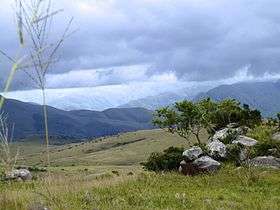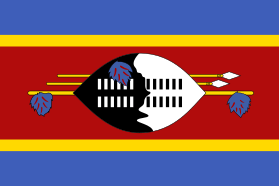Malolotja National Park
Malolotja National Park covers 18,000 hectares (44,000 acres) of mountain wilderness on Eswatini's northwestern border with South Africa. The park includes Ngwenya Mountain, Eswatini's second highest mountain (1,829 m),[1] and Malolotja Falls which drop 89 metres (292 ft), the highest in Eswatini.[2] Habitats include short grassland to thick riverine scrub, bushveld and Afromontane forest.[1]

Malolotja National Park adjoins the Songimvelo Game Reserve in South Africa, and together they form the Songimvelo-Malolotja Transboundary Protected Area or Peace Park, which in turn is part of the Lubombo Transfrontier Conservation Area.[3][4]
History
The region was identified as important by the Swaziland National Trust Commission in the early 1970s. At that time most of the area was sheep grazing land and much was privately owned. However, the area had little agricultural potential and residents were resettled on good agricultural land adjacent to Malolotja.[1]
Flora and fauna
Animals in the park include zebra, wildebeest, reedbuck, blesbok, red hartebeest, oribi, leopard, serval, aardwolf, jackal and bushpig.[2] The Natal ghost frog, plaintive rain frog and the gray's stream frog are endemic to Eswatini, South Africa and Lesotho. In Eswatini they have only been found in Afromontane mist belt forest.[5]
Bird species include louries, sunbirds, sugarbirds, blue cranes and swallows. Bald ibises nest in colony on cliffs near Malolotja Falls.[2] A number of bird species are of conservation importance, because their habitat is limited and threatened outside the park. They are the orange ground-thrush, brown robin, bush blackcap, chorister robin-chat, white-starred robin, grey cuckoo-shrike, olive bush shrike, southern boubou, Narina trogon and Knysna lourie.[5]
There are tall grasses, orchids, lilies, and ancient cycads.[2]
Climate
Most rain falls in summer thunderstorms from December to April. Frost is common in June and July.[2]
Ngwenya Mine
The Ngwenya iron ore mine is located within the park, near the Hawane Dam. Salgaocar is the company that is contracted to extract over 32 million tons of ore, amid much protest from locals over environmental repercussions and the detriment to one of the nation's main water supplies.[6]
Tourism
There are only 25 kilometres (16 mi) of road in the park, but much more can be explored on 4×4s, mountain bike or by hiking.[2] There are a number of designated camping sites.[7]
See also
- List of birds of Eswatini
- List of mammals of Eswatini
References
- "Malolotja Nature Reserve". Swaziland National Trust Commission. Retrieved 2009-10-17.
- "SWAZILAND - MALOLOTJA NATURE RESERVE". Game-Reserve.com. Retrieved 2009-10-17.
- "Lubombo Transfrontier Conservation And Resource Area". South Africa: Department of Environmental Affairs and Tourism. Archived from the original on October 2, 2006. Retrieved 2009-10-18.
- Dlamini, Wisdom M. D. (2005). "Songimvelo-Malolotja TFCA". Swaziland National Trust Commission. Retrieved 2009-10-18.
- Boycott, Richard C. (31 December 1997). "The Conservational Importance of the Mgwayiza Mist Belt Forest, Malolotja Nature Reserve, Swaziland". Malolotja Nature Reserve: Environmental Centre for Swaziland. Archived from the original on 28 July 2011. Retrieved 2009-10-18.
- Nellie Bowles (31 August 2012). "Swaziland's Ngwenya mine extracts its ore and exacts its price". Mail & Guardian.
- "Malolotja Nature Reserve". Footprint Hiking Club. Retrieved 2009-10-17.
